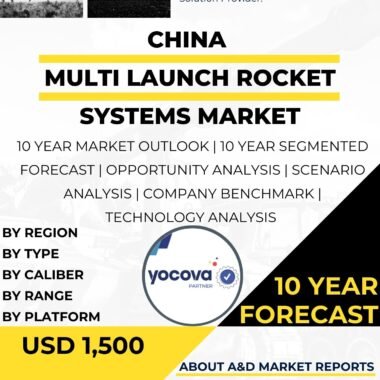Description
The Multiple Launch Rocket System (MLRS) market in Malaysia has witnessed significant developments and growth in recent years, reflecting the country’s commitment to enhancing its defense capabilities and bolstering its military preparedness. MLRSs play a crucial role in modern artillery systems, providing the Malaysian Armed Forces with enhanced firepower, rapid response capabilities, and versatile operational options.
As a nation with strategic geopolitical importance in Southeast Asia, Malaysia faces diverse security challenges, including potential threats from hostile forces or regional instability. The integration of advanced MLRS systems into its defense strategy enables Malaysia to establish a robust and modern defense posture.
The adoption of modern MLRS systems offers several significant advantages. These advanced artillery systems use multiple rockets or missiles to saturate a designated target area, providing a significant advantage in terms of firepower over traditional single-round artillery systems. With a larger number of projectiles launched simultaneously, MLRSs can neutralize a broader range of targets, making them effective for various military operations.
Moreover, MLRSs provide rapid response capabilities, allowing the Malaysian Armed Forces to quickly engage and suppress enemy threats. The ability to deliver multiple munitions on target in a short period enhances the military’s flexibility and responsiveness, especially in dynamic and fast-paced operational scenarios.
Additionally, MLRS systems offer a versatile operational option, as they can be equipped with various types of rockets or missiles, each tailored for specific mission requirements. Different munitions can be selected based on factors like target type, range, and payload, making MLRSs adaptable to various operational environments.
The Malaysian government has recognized the importance of international collaborations in acquiring and developing MLRS technologies. Partnerships with leading global defense companies and technology providers have facilitated access to cutting-edge MLRS systems and expertise. These collaborations have enabled technology transfer and capacity building, contributing to the growth of Malaysia’s domestic MLRS capabilities.
Furthermore, Malaysia has been actively investing in local research and development (R&D) initiatives to foster indigenous MLRS technologies. By encouraging homegrown innovation, Malaysia aims to achieve self-reliance in MLRS development and strengthen its defense industrial base.
While the MLRS market in Malaysia shows promise, it is not without challenges. One of the primary hurdles is the high cost of developing and acquiring advanced MLRS systems. These sophisticated artillery systems require significant investment in research, development, and testing. Budget constraints may impact the pace and scale of MLRS acquisition and development efforts.
Moreover, MLRS systems must meet stringent safety and performance standards. The effectiveness of MLRS largely depends on the reliability and accuracy of their rockets or missiles. Ensuring the safety and dependability of MLRS technologies is vital to successful military operations.
Additionally, MLRS development requires specialized engineering expertise and access to advanced materials and manufacturing processes. Addressing these technological challenges is essential to enhancing Malaysia’s indigenous MLRS capabilities.
Looking ahead, the MLRS market in Malaysia is poised for further growth. The government’s commitment to modernizing its defense capabilities and adopting advanced technologies will drive continued investments in MLRS systems. As MLRS technologies continue to evolve and demonstrate their effectiveness, they are likely to play an increasingly pivotal role in Malaysia’s defense and security strategy.
Moreover, Malaysia’s participation in regional security collaborations and joint military exercises will likely influence its MLRS requirements. As the country seeks to strengthen its position as a key player in regional security and defense cooperation, the demand for advanced MLRS systems with interoperability and compatibility with allied forces will increase.
In conclusion, the MLRS market in Malaysia has experienced significant growth and progress. The government’s focus on enhancing its defense capabilities and investing in advanced MLRS technologies has paved the way for the integration of modern MLRS systems into its military strategy. International collaborations and domestic research efforts have positioned Malaysia as a participant in the global MLRS landscape.
However, challenges related to budget constraints, technology development, safety standards, and engineering expertise must be addressed proactively to sustain and enhance the growth of the MLRS market in the years to come. By maintaining a modern and capable MLRS capability, Malaysia can effectively enhance its defense posture, deter potential threats, and bolster its overall military preparedness.




